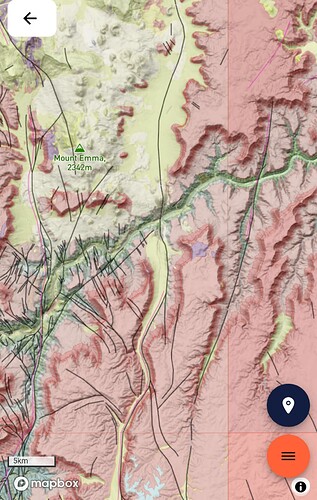" The carving of the Grand Canyon is said to have begun during the Cenozoic (about 6 millions ago supposedly). But, again, the Grand Canyon does not contain Cenozoic strata."
It does contain Cenozoic strata. Explanation:
You’re still not addressing my comments. The issue is a matter of order. Erosion by the Colorado post dates structural deformation. And what do you mean there is no Cenozoic strata? There’s plenty of Cenozoic strata within grand canyon national park and outside or beyond the national park as well.
My response:
A. The grand canyon does contain Cenozoic strata.
B. The Colorado river doesn’t exist in a little bubble where it just stops existing the moment you leave a national park. And;
C. None of this addresses the issue of structural deformation predating erosion by the river.
Let’s see if my image loads. Attached, in yellow, is some Cenozoic strata, SE if Mt Emma, within the national park.
Nobody should overlook this fact, what you just did is you argued something that was blatantly incorrect. You should stop stating incorrect information and spend more time asking questions.
Heres another image over by the lake Meade recreational area. And again you can see in yellow, Cenozoic strata.
But again, the main point here is that erosion by the river post dates structural deformation of underlying strata. This is just a simple known fact, and it’s well known. It’s very well established and clear.
And this is a problem for people who think that all of this stratigraphy formed in some sort of rapid soft sediment washout.
And another note here, you can even see how there are fractures running through various periods of strata, further demonstrating that these were dense and lithified solid bodies of rock, prior to deformation and uplift, and further prior to erosion by the Colorado, as a product of that uplift.
And then you said something like "In fact, most even of Mesozoic strata has been eroded. ".
Well yea, and what time occurs after the mesozoic? the cenozoic. So if you have erosion of mesozoic strata, then you know that the erosion occurred after the deposition of that mesozoic strata. During the cenozoic. But still, just to keep pulling us back to the same original point that cannot be stressed enough, the erosional forces, the colorado river and wind erosion as well, post-date structural deformation observed throughout the paleozoic strata as a product of orogenesis. Uplift and fracturing occurs prior to lacustrine erosion and incision.
And this is a blatant issue for anyone who suggests that earth is a few thousand years old. And these features are observed worldwide. Its no secret or anything.


